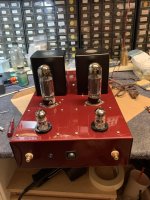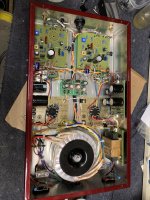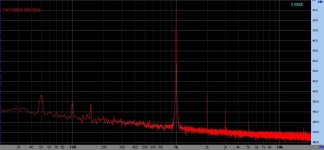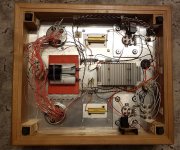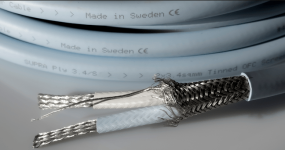Probably overkill, but...
Spacing from output banana jacks/binding posts is about 3-4 inches, call it about 7-10cm.
I'm thinking ANY extra shielding I can add to this might be of benefit. Wavelength of WiFi and cellular is in the 6-12.5cm range. With my Willsenton R8 and Tektron TK2 2A3/50S-I amps, if I'm within a few feet of EITHER with a cell phone I get some interesting noise out of my speakers. All KINDS of signals coming off cell phone, and LED lights, and blue tooth, and 2.4/5gHz wifi, all the cell phone bands, local ham radio guy next door, all the rest.

I have some good quality teflon-coated shielded wiring I'm thinking of using here. Does it matter? I use shielded speaker cables, INPUT to 6SN7 front end is shielded, why wouldn't it?
So my question is, do BOTH ends of the shield connect? One end to post, other to OPT then to ground or just ONE end, like shielding an AC power cable?
Thanks.
NB
Spacing from output banana jacks/binding posts is about 3-4 inches, call it about 7-10cm.
I'm thinking ANY extra shielding I can add to this might be of benefit. Wavelength of WiFi and cellular is in the 6-12.5cm range. With my Willsenton R8 and Tektron TK2 2A3/50S-I amps, if I'm within a few feet of EITHER with a cell phone I get some interesting noise out of my speakers. All KINDS of signals coming off cell phone, and LED lights, and blue tooth, and 2.4/5gHz wifi, all the cell phone bands, local ham radio guy next door, all the rest.
I have some good quality teflon-coated shielded wiring I'm thinking of using here. Does it matter? I use shielded speaker cables, INPUT to 6SN7 front end is shielded, why wouldn't it?
So my question is, do BOTH ends of the shield connect? One end to post, other to OPT then to ground or just ONE end, like shielding an AC power cable?
Thanks.
NB
Last edited:
If you have EMC disturbances, must to detect the input path of interference.
Usually it occurs, if the device input is infected: inner input cabling, poorly designed interconnect, wrong grounding between source and amplifier (for example if you use simple shielded cable as interconnect, both shield connected to source and amplifier ground).
The other possible cause is the PSU + power line. Sometimes safety ground wire is the reason of disturbance.
See there https://rfimmunity.com/resources/about-emcemirfi/.
If you use shielded inner input cable (hot, cold, shield -grounded only in "source" side: RCA-), shielded interconnect, try this:
plug interconnect to amplifier, short other end of interconnect and detect (cell phone, WiFi other) disturbances.
If disturbances occurs, try to suppress RFI with filter.
p.s.
IMHO the shielded (hot, cold, shield ?) speaker cable is the snake oil category. There is the signal volume size is few Volt (and generates significant power), the RFI disturbance few mV and its power (on loudspeaker) practically undetectable by ear.
Usually it occurs, if the device input is infected: inner input cabling, poorly designed interconnect, wrong grounding between source and amplifier (for example if you use simple shielded cable as interconnect, both shield connected to source and amplifier ground).
The other possible cause is the PSU + power line. Sometimes safety ground wire is the reason of disturbance.
See there https://rfimmunity.com/resources/about-emcemirfi/.
If you use shielded inner input cable (hot, cold, shield -grounded only in "source" side: RCA-), shielded interconnect, try this:
plug interconnect to amplifier, short other end of interconnect and detect (cell phone, WiFi other) disturbances.
If disturbances occurs, try to suppress RFI with filter.
p.s.
IMHO the shielded (hot, cold, shield ?) speaker cable is the snake oil category. There is the signal volume size is few Volt (and generates significant power), the RFI disturbance few mV and its power (on loudspeaker) practically undetectable by ear.
Shielding speaker out wiring is nonsense, RF interference is not getting injected there, by any means.
It is getting into your amp somewhere else.
Think a high impedance point, such as a few hundred kOhm (tube grids), not 4/8 ohm speaker impedance, and amplification (again tube grids), not zero gain passive wiring.
It is getting into your amp somewhere else.
Think a high impedance point, such as a few hundred kOhm (tube grids), not 4/8 ohm speaker impedance, and amplification (again tube grids), not zero gain passive wiring.
Perhaps I am not understanding your picture in Post # 1:
A Wooden box around a tube amplifier is Not a good RF shield.
Go try and build an RF screen room using Wood.
If you find your Hashimoto transformers are causing any problem, quote me a price, and I will purchase them.
A Wooden box around a tube amplifier is Not a good RF shield.
Go try and build an RF screen room using Wood.
If you find your Hashimoto transformers are causing any problem, quote me a price, and I will purchase them.
Last edited:
@euro21 - That’s a bingo! Very helpful. I’ve held a Ham Radio license “extra” for over ten years, put up several towers, grounding is STILL something I don’t understand completely and probably won’t in this lifetime. Thanks for the reference, I’ll keep an open tab on my iPad for review.
@JMFahey - This amp isn’t complete, I was referring to two others, and your answer fits/confirms what I was thinking. A steel box around one amp and I STILL have some “cell phone noise” led me to believe exposed TUBE components were resonating with the very short wavelengths involved in various transmitters. There’s still time for me to build a faraday cage out of chicken wire in my “man cave” in our new home. 😉
@audiohead I got the pair for a good deal after reading similar praise elsewhere. Nice build there, thanks for the photos, they were VERY helpful sorting some things out. I didn’t know until I started soldering leads to the binding posts on the OPTs last night that they have GROOVES in the center for wire placement. VERY convenient and nothing in the instructions (pictorial - I don’t read Japanese).
@6A3sUMMER Wood seems to work fine for Tektron. That wasn’t my question, but thanks for taking the time to answer whatever it was you heard in your head.🤔
@JMFahey - This amp isn’t complete, I was referring to two others, and your answer fits/confirms what I was thinking. A steel box around one amp and I STILL have some “cell phone noise” led me to believe exposed TUBE components were resonating with the very short wavelengths involved in various transmitters. There’s still time for me to build a faraday cage out of chicken wire in my “man cave” in our new home. 😉
@audiohead I got the pair for a good deal after reading similar praise elsewhere. Nice build there, thanks for the photos, they were VERY helpful sorting some things out. I didn’t know until I started soldering leads to the binding posts on the OPTs last night that they have GROOVES in the center for wire placement. VERY convenient and nothing in the instructions (pictorial - I don’t read Japanese).
@6A3sUMMER Wood seems to work fine for Tektron. That wasn’t my question, but thanks for taking the time to answer whatever it was you heard in your head.🤔
not correct speaker cables are an antennas and by feedback path jump inShielding speaker out wiring is nonsense, RF interference is not getting injected there, by any means.
It is getting into your amp somewhere else.
Think a high impedance point, such as a few hundred kOhm (tube grids), not 4/8 ohm speaker impedance, and amplification (again tube grids), not zero gain passive wiring.
Antennas shorted by 4/8 ohm speaker impedance are not much of an antenna.
Microvolts RF signals compared to , say, TEN VOLTS speaker signal are again nothing
"Just do the Math"
or:
"The Devil is in the Details"
apply here.
SHOW IT or it doesn't exist.
By the way:
"I have some good quality teflon-coated shielded wiring I'm thinking of using here. Does it matter? I use shielded speaker cables" squarely puts this none proof none Science thread squarely in the "Audio Cable thread" 😄 class , what did I expect?🤔
Microvolts RF signals compared to , say, TEN VOLTS speaker signal are again nothing
"Just do the Math"
or:
"The Devil is in the Details"
apply here.
Tektron uses wood for shielding?Wood seems to work fine for Tektron
SHOW IT or it doesn't exist.
By the way:
"I have some good quality teflon-coated shielded wiring I'm thinking of using here. Does it matter? I use shielded speaker cables" squarely puts this none proof none Science thread squarely in the "Audio Cable thread" 😄 class , what did I expect?🤔
Last edited:
Um, I did NOT say Tektron used wood for shielding. Simply that it works for them. Now how, not on what, but they seem to sell quite a few with wooden frames which, as I’ve proven to my own satisfaction with another amplifier that has a metal box/frame, is affected by cell phones just as much. YMMV.
We are talking interference here, hence shielding.
Whatever furniture the metal chassis is put in, is irrelevant.
Whatever furniture the metal chassis is put in, is irrelevant.
Generally, when in the presence of various types of EMI fields:
A speaker cable with a loudspeaker at the far end, will Not introduce differential EMI into the amplifier.
A speaker cable with a loudspeaker at the far end, Does introduce common mode EMI into the amplifier.
Any common mode interference, and any differential interference, that 'gets into an amplifier' is a potential problem.
EMI (Electro Magnetic Interference) is not always well understood.
EMC (Electro Magnetic Compatibility) in many cases is an Oxymoron.
A speaker cable with a loudspeaker at the far end, will Not introduce differential EMI into the amplifier.
A speaker cable with a loudspeaker at the far end, Does introduce common mode EMI into the amplifier.
Any common mode interference, and any differential interference, that 'gets into an amplifier' is a potential problem.
EMI (Electro Magnetic Interference) is not always well understood.
EMC (Electro Magnetic Compatibility) in many cases is an Oxymoron.
If a cell phone is causing interference in an audio amplifier, either the amplifier is oscillating or there is RF rectification going on inside the amp. Oscillation can either be a global loop problem, or local oscillation that a grid stopper should fix. RF rectification usually happens on INPUT stages, overloading them, causing nonlinearity in the audio you’re trying to reproduce at the same time. It doesn’t get into the output as easily, unless you’re right at the base of a megawatt tower. A cell phone doesn’t have enough EIRP to overload output tubes, but it might find its way into a 12AX7 in the front end. In that case you just need to filter the RF out… of the input (or possibly feedback) signal.
- Home
- Amplifiers
- Tubes / Valves
- Output Transformer Wiring question
